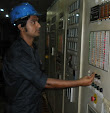PTC Thermistors
All metals may be called PTC materials, however, their temperature coefficients of resistivity (TCR) are quite low . An RTD as described earlier also has a small PTC. In contrast, ceramic PTC materials in a certain temperature range are characterized by a very large temperature dependence. The PTC thermistors are fab-ricated of polycrystalline ceramic substances, where the base compounds, usually barium titanate or solid solutions of barium and strontium titanate (highly resistive materials), are made semiconductive by the addition of dopants. Above the Curie temperature of a composite material, the ferroelectric properties change rapidly, re-sulting in a rise in resistance, often several orders of magnitude.
A typical transferfunction curve for the PTC thermistor is shown in Fig.(above), in a comparison with the NTC and RTD responses. The shape of the curve does not lend itself to an easy math- ematical approximation; therefore, manufacturers usually specify PTC thermistors by a set of numbers:
- Zero power resistance, R25,at25◦C, where self-heating is negligibly small.
- Minimum resistance Rm is the value on the curve where the thermistor changes its TCR from positive to negative value (point m).
- Transition temperature Tτ is the temperature where resistance begins to changerapidly. It coincides approximately with the Curie point of the material. A typical range for the transition temperatures is from −30◦Cto +160◦C (Keystone Carbon Co.).
- hermal characteristics are specified by a thermal capacity, a dissipation constant δ (specified under given conditions of coupling to the environment), and a thermal time constant (defines speed response under specified conditions).
- Maximum voltage Emax is the highest value the thermistor can withstand at any temperature.
It is important to understand that for the PTC thermistors, two factors play a key role: environmental temperature and a self-heating effect. Either one of these two factors shifts the thermistor’s operating point. The temperature sensitivity of the PTC thermistor is reflected in the volt–ampere characteristic of Fig. below. According to Ohm’s law, a regular resistor with a near-zero TCR has a linear characteristic. A NTC thermistor has a positive curvature of the volt–ampere dependence. An implication of the negative TCR is that if such a thermistor is connected to a hard voltage source,5 a self-heating due to Joule heat dissipation will result in resistance reduction. In turn, that will lead to a further increase in current and more heating. If the heat outflow from the NTC thermistor is restricted, a self-heating may eventually cause overheating and a catastrophic destruction of the device. Because of positive TCRs, metals do not overheat when connected to hard voltage sources and behave as self-limiting devices. For instance, a filament in an incandes-cent lamp does not burn out because the increase in its temperature results in an increase in resistance, which limits current. This self-limiting (self-regulating) effect is substantially enhanced in the PTC thermistors. The shape of the volt–ampere char acteristic indicates that in a relatively narrow temperature range, the PTC thermistor possesses a negative resistance; that is,










